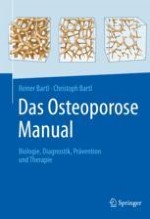2021 | OriginalPaper | Buchkapitel
58. Knochenmarködem-Syndrom und komplexes regionales Schmerzsyndrom
verfasst von : Reiner Bartl, Christoph Bartl
Erschienen in: Das Osteoporose Manual
Verlag: Springer Berlin Heidelberg
Zusammenfassung
-
Das führende Symptom eines Knochenmarködems (KMÖ) sind dumpfe, tiefe Knochenschmerzen, auch in Ruhe.
-
In der Pathogenese des Knochenmarködems kommt dem hyperaktiven Osteoklasten eine Schlüsselrolle zu. Der frühe Einsatz moderner antiresorptiver Substanzen kann die Kaskade entzündlicher Reaktionen und überstürzten osteoklastischen Knochenabbaus stoppen und die Erkrankung heilen.
-
Die Pathogenese des Knochenmarködem-Syndroms ist vielfältig und umfasst traumatische, ischämische und reaktive Ursachen.
-
Antiresorptive Substanzen wie Ibandronat, Zoledronat oder Denosumab sind heute die First-Line-Therapie. In der Regel reicht eine kurzfristige Stoßtherapie (z. B. 3 Infusionen mit Ibandronat 6 mg). Schmerzerleichterung und MRT-Kontrollen bestimmen die Therapiedauer. Auch vasoaktive Substanzen zur Verbesserung der intraossären Durchblutung (Prostazykline-Iloprost) werden eingesetzt.
-
Das komplexe regionale Schmerzsyndrom (Complex Regional Pain Syndrome, CRPS I und II, früher als Morbus Sudeck bezeichnet) zeigt einen chronischen schmerzhaften Verlauf über drei klinische Stadien und mündet in der Regel in eine Knochenatrophie (lokale Osteoporose). Auch bei dieser entzündlichen Erkrankung spielt der hyperaktive Osteoklast die Hauptrolle in der Pathogenese. Antiresorptive Substanzen werden zur Schmerzlinderung und Wiederherstellung der lokalen Knochensubstanz eingesetzt.
-
Die transiente Osteoporose, in Wirklichkeit ein Knochenmarködem im Bereich der Hüfte, tritt im letzten Trimenon der Schwangerschaft auf. Falls sich keine Spontanremission nach der Geburt einstellt, können nach der Stillzeit antiresorptive Substanzen mit Erfolg eingesetzt werden.














